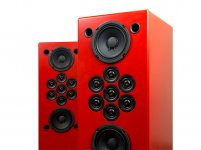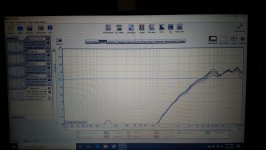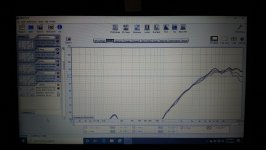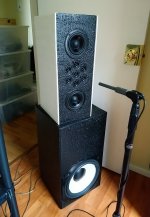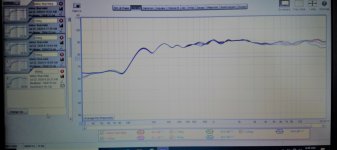This is by my friend Rick Craig of Selah Audio in Canada. )
Steve- Rick lives in North Carolina. He is not Canadian.
Wolf
or something like tekton?
i got hundreds of tweeters, perhaps i will try something like this
Can someone explain the theory behind the array of tweeters? I don't understand the advantage this brings. Thanks!
Attachments
Directivity may be the aim. Adason's work here has given us a taste, and to that end perhaps it would be beneficial to see the measurements:csample said:Can someone explain the theory behind the array of tweeters?
1. out to an angle where the beamwidth bounds are apparent.
2. with a finer angular resolution so that lobing effects can be discerned
3. zoomed on the Y-axis so that resonances and diffractions might be seen.
Sorry, I missed this link in post #99 when I asked for help understanding the tweeter array. This is what I was looking for.Its discussed here:
Help Understanding Tekton Tweeter Array Schematic?
i just measured the tekton tweeter array, just tweeters, both horizontally, which was done before together with midbasses, but now just tweeters, horizontally, and vertically
it measured great, no beaming, whether you sit, or stand up, you get great sound
this speaker images well, nice wide sweet spot
i will post pictures when i get the chance
while ago, when i was working on my main speaker, nola like, with four midbasses, at one point i experimented with short line array of four tweeters, exactly like nola, and I did not like it...it was unpleasantly beaming, I had to be in the sweet spot to hear perfect treble, and I did not liked it, It was against all my beliefs, that of axis sound, which we hear tens of milliseconds later, must be as close as possible to first arriving signal
this tekton array has very wide spray all the way up 20kHz, minimal beaming, both axis, all up to 40deg, I like the sound
minor observation is that is has three bumps on the fr response, as they are 3 sections of tweeters, but I do not think its noticeable
it measured great, no beaming, whether you sit, or stand up, you get great sound
this speaker images well, nice wide sweet spot
i will post pictures when i get the chance
while ago, when i was working on my main speaker, nola like, with four midbasses, at one point i experimented with short line array of four tweeters, exactly like nola, and I did not like it...it was unpleasantly beaming, I had to be in the sweet spot to hear perfect treble, and I did not liked it, It was against all my beliefs, that of axis sound, which we hear tens of milliseconds later, must be as close as possible to first arriving signal
this tekton array has very wide spray all the way up 20kHz, minimal beaming, both axis, all up to 40deg, I like the sound
minor observation is that is has three bumps on the fr response, as they are 3 sections of tweeters, but I do not think its noticeable
The tweeters.
The higher you go, the less of them are running full volume.
That right Adason ? YES
Otherwise, move out of the sweet spot and you lose sparkle, or it will sound muffled. NO
here are stereophile measurements
Tekton Design Impact Monitor loudspeaker Measurements | Stereophile.com
horizontal (fig4) looks nice, not too directional
vertical has lobing, but in midrange
What's shading?Do all the tweeters in the original Tekton get the same signal or is there shading?
What's shading?
The term "shading" is used in sonar, in medical ultrasound it would be called "apodization," in both cases referring to a spatially varying amplitude that affects the radiation pattern. A Gaussian amplitude distribution across a radiating aperture will give a slightly wider main beam and lower sidelobes.
Since the crossover for the tweeters is different for the middle, top two, and side four tweeters, there will be a frequency dependent amplitude difference that affects the radiation pattern. This is probably one of the design intentions.
Incidentally, when I discussed the design with the vendor at the Capitol Audio Fest last Fall, he talked more about the lower moving mass of the sum of the tweeters compared with a conventional direct radiator.
___________________
Mike
Anyway, I find a real drawback of MTM is M units do not move exactly the same. Moving detached 2 membranes adds very slight something, makes overall sounds a little less organic and less intimate. I don't know how I should call this effect. It's not as bad as 6 string guitar vs 12 strings, but it's audible. For people who prefer full range to multi units, it's would not be trivial, and it should be considered.
What exactly, pray tell, does 'organic sound' sound like? I understand intimate, rich, full, thin, screechy, distorted, sharp, dull, muted, forward, and many other adjectives to describe the characteristic of sound from speakers. But I have absolutely no idea what an organic speaker sounds like. Perhaps you can describe the sound for the rest of us.
added side wall, remeasured, looks good, I am happy, it sounds very good, highly recommended
Looks nice! How many degrees off axis are your measurements? (I can't quite read the legend at the bottom of the screen)
- Status
- This old topic is closed. If you want to reopen this topic, contact a moderator using the "Report Post" button.
- Home
- Loudspeakers
- Multi-Way
- MTM sound characteristics
